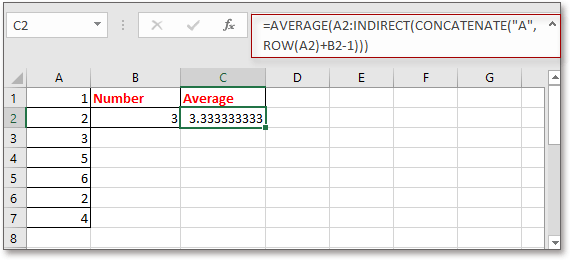Excel'de başka bir hücre değerine dayalı olarak aralık nasıl tanımlanır?
Değerlerin bir aralığını hesaplamak, çoğu Excel kullanıcısı için kolaydır, ancak belirli bir hücredeki sayıya göre değerlerin bir aralığını hesaplamayı denediniz mi? Örneğin, A sütununda bir dizi değer var ve B2 hücresindeki değere göre A sütunundaki değer sayısını hesaplamak istiyorum. Bu, B2'de 4 varsa, A sütunundaki ilk 4 değerin ortalamasını alacağım anlamına gelir (aşağıdaki ekran görüntüsüne bakın). Şimdi size Excel'de başka bir hücre değerine göre aralık tanımlamak için basit bir formül tanıtacağım.
Hücre değerine göre aralık tanımla
 Hücre değerine göre aralık tanımla
Hücre değerine göre aralık tanımla
Başka bir hücre değerine dayalı olarak bir aralık için hesaplama yapmak için basit bir formül kullanabilirsiniz.
Sonucu gireceğiniz boş bir hücre seçin ve bu formülü yazın =AVERAGE(A1:INDIRECT(CONCATENATE("A",B2))), ve ardından Enter tuşuna basın ve sonucu alın.
1. Formülde, A1, hesaplamak istediğiniz sütundaki ilk hücredir, A hesapladığınız sütundur, B2 ise hesaplamaya dayandığınız hücredir. Bu referansları ihtiyaçlarınıza göre değiştirebilirsiniz.
2. Toplam almak istiyorsanız, bu formülü kullanabilirsiniz: =SUM(A1:INDIRECT(CONCATENATE("A",B2))).
3. Tanımlamak istediğiniz ilk veri Excel'deki ilk satırda değilse, örneğin A2 hücresindeyse, şu formülü kullanabilirsiniz: =AVERAGE(A2:INDIRECT(CONCATENATE("A",ROW(A2)+B2-1))).
Excel'de arka plan veya biçimlendirme rengine göre hücreleri hızlıca sayma/toplama |
Bazı durumlarda, birden fazla renge sahip bir hücre aralığınız olabilir ve yapmak istediğiniz aynı renge dayalı olarak değerleri saymak ya da toplamak. Bunu nasıl hızlıca hesaplayabilirsiniz? Kullanarak Kutools for Excel'inCount by Color, özelliğiyle renklere göre birçok hesaplama yapabilir ve ayrıca hesaplanan sonuçların bir raporunu oluşturabilirsiniz. Kutools'u indirin ve bugün deneyin! |
Kutools for Excel - Excel'i 300'den fazla temel araçla güçlendirin. Sürekli ücretsiz AI özelliklerinden yararlanın! Hemen Edinin |
En İyi Ofis Verimlilik Araçları
Kutools for Excel ile Excel becerilerinizi güçlendirin ve benzersiz bir verimlilik deneyimi yaşayın. Kutools for Excel, üretkenliği artırmak ve zamandan tasarruf etmek için300'den fazla Gelişmiş Özellik sunuyor. İhtiyacınız olan özelliği almak için buraya tıklayın...
Office Tab, Ofis uygulamalarına sekmeli arayüz kazandırır ve işinizi çok daha kolaylaştırır.
- Word, Excel, PowerPoint'te sekmeli düzenleme ve okuma işlevini etkinleştirin.
- Yeni pencereler yerine aynı pencerede yeni sekmelerde birden fazla belge açıp oluşturun.
- Verimliliğinizi %50 artırır ve her gün yüzlerce mouse tıklaması azaltır!
Tüm Kutools eklentileri. Tek kurulum
Kutools for Office paketi, Excel, Word, Outlook & PowerPoint için eklentileri ve Office Tab Pro'yu bir araya getirir; Office uygulamalarında çalışan ekipler için ideal bir çözümdür.
- Hepsi bir arada paket — Excel, Word, Outlook & PowerPoint eklentileri + Office Tab Pro
- Tek kurulum, tek lisans — dakikalar içinde kurulun (MSI hazır)
- Birlikte daha verimli — Ofis uygulamalarında hızlı üretkenlik
- 30 günlük tam özellikli deneme — kayıt yok, kredi kartı yok
- En iyi değer — tek tek eklenti almak yerine tasarruf edin